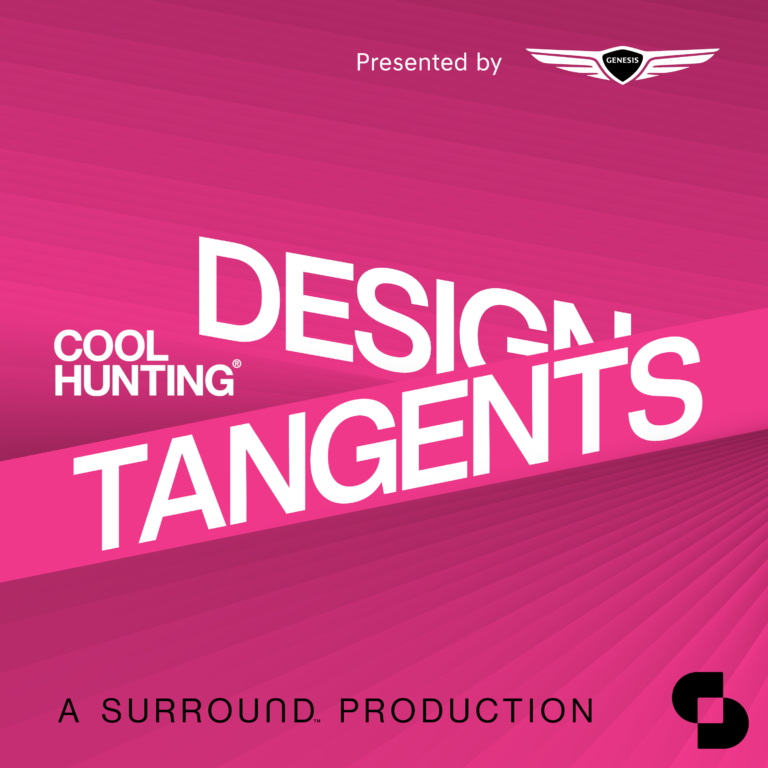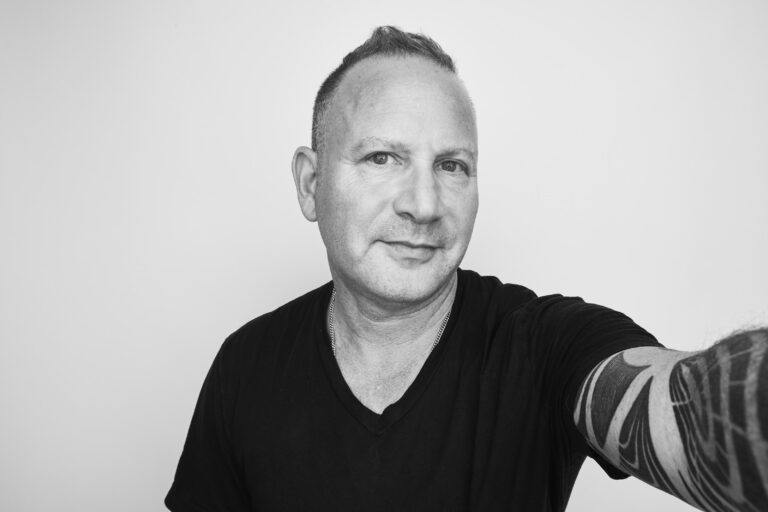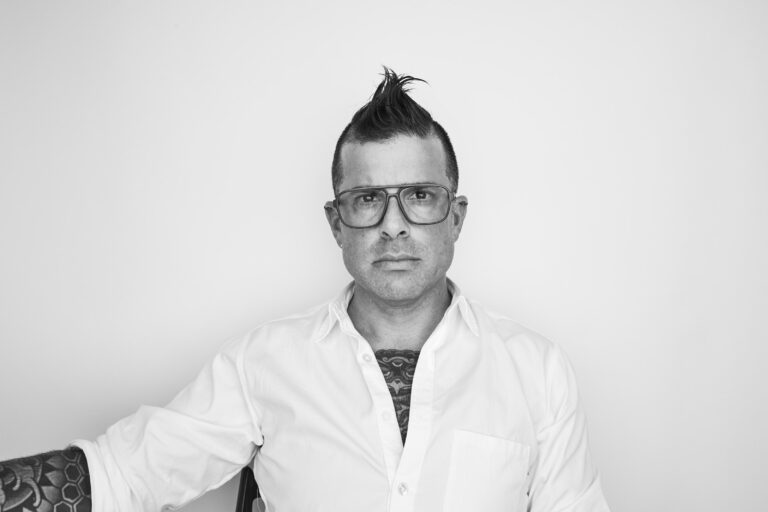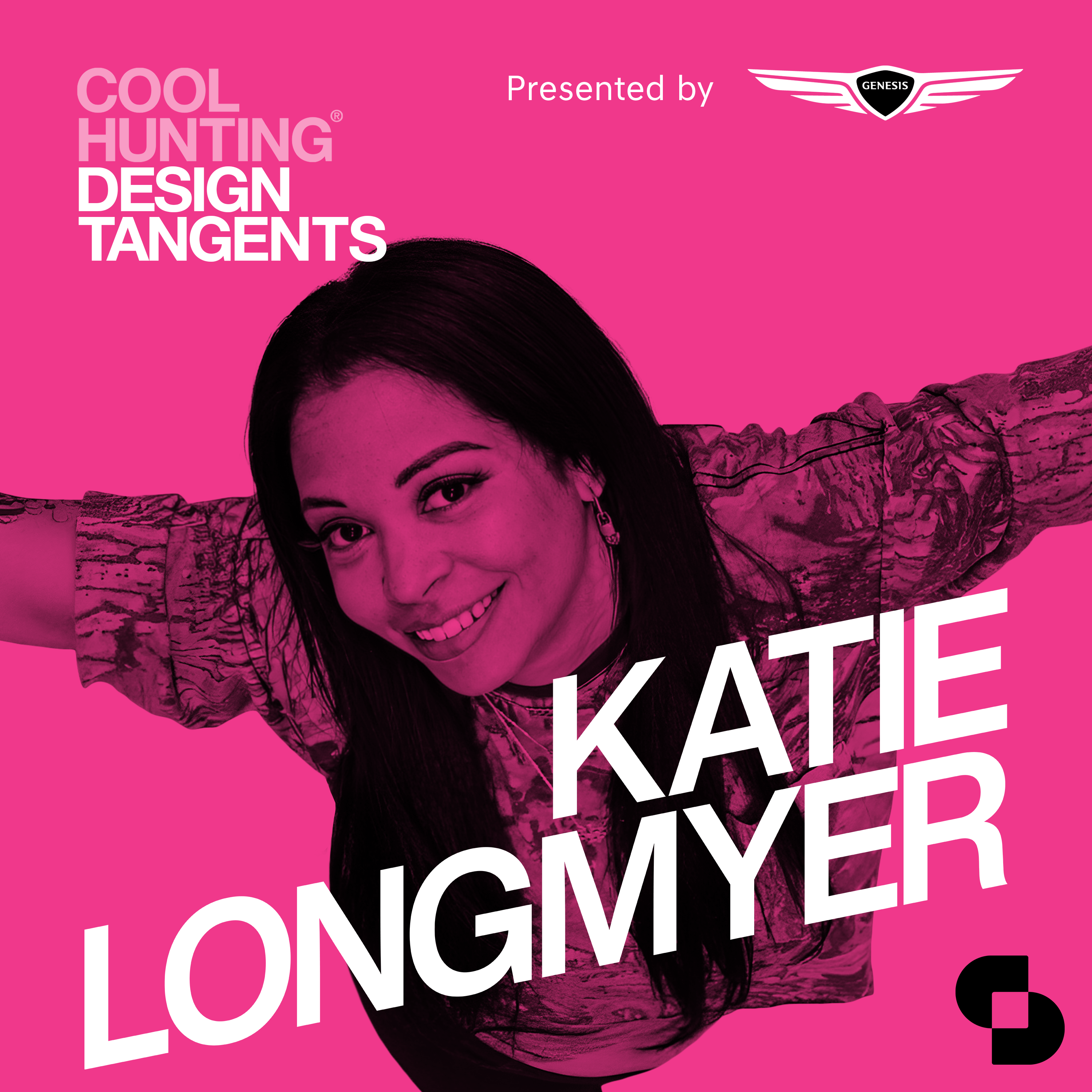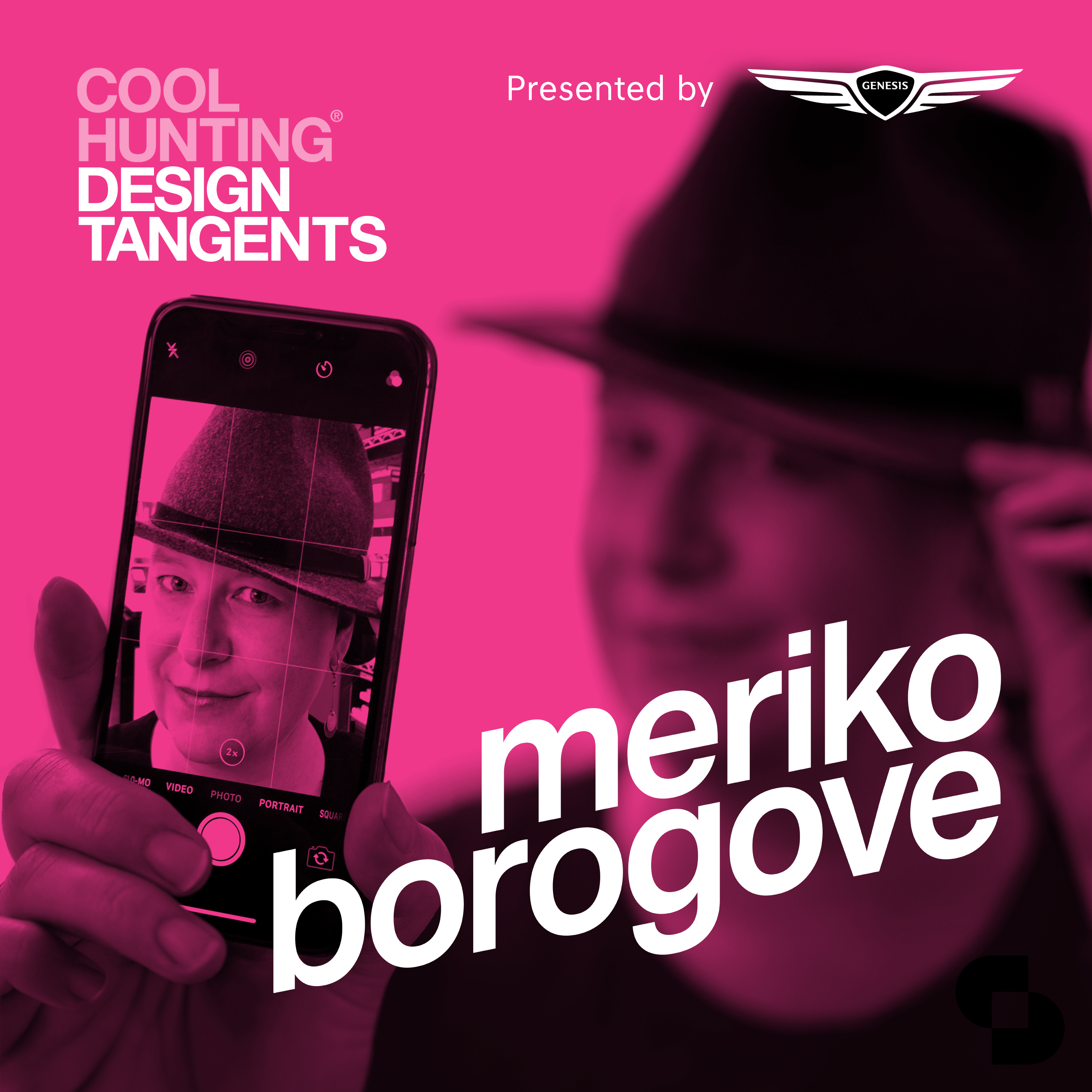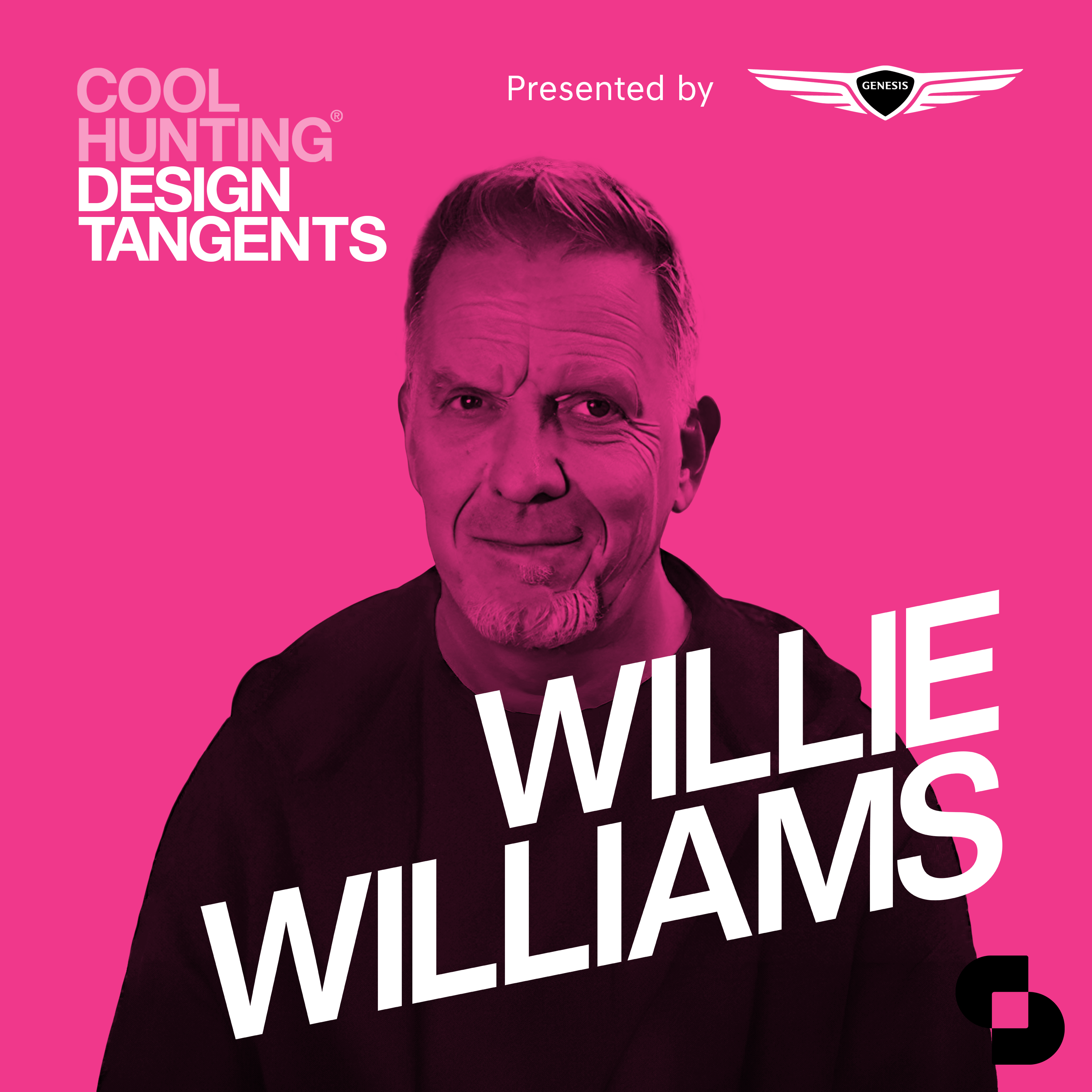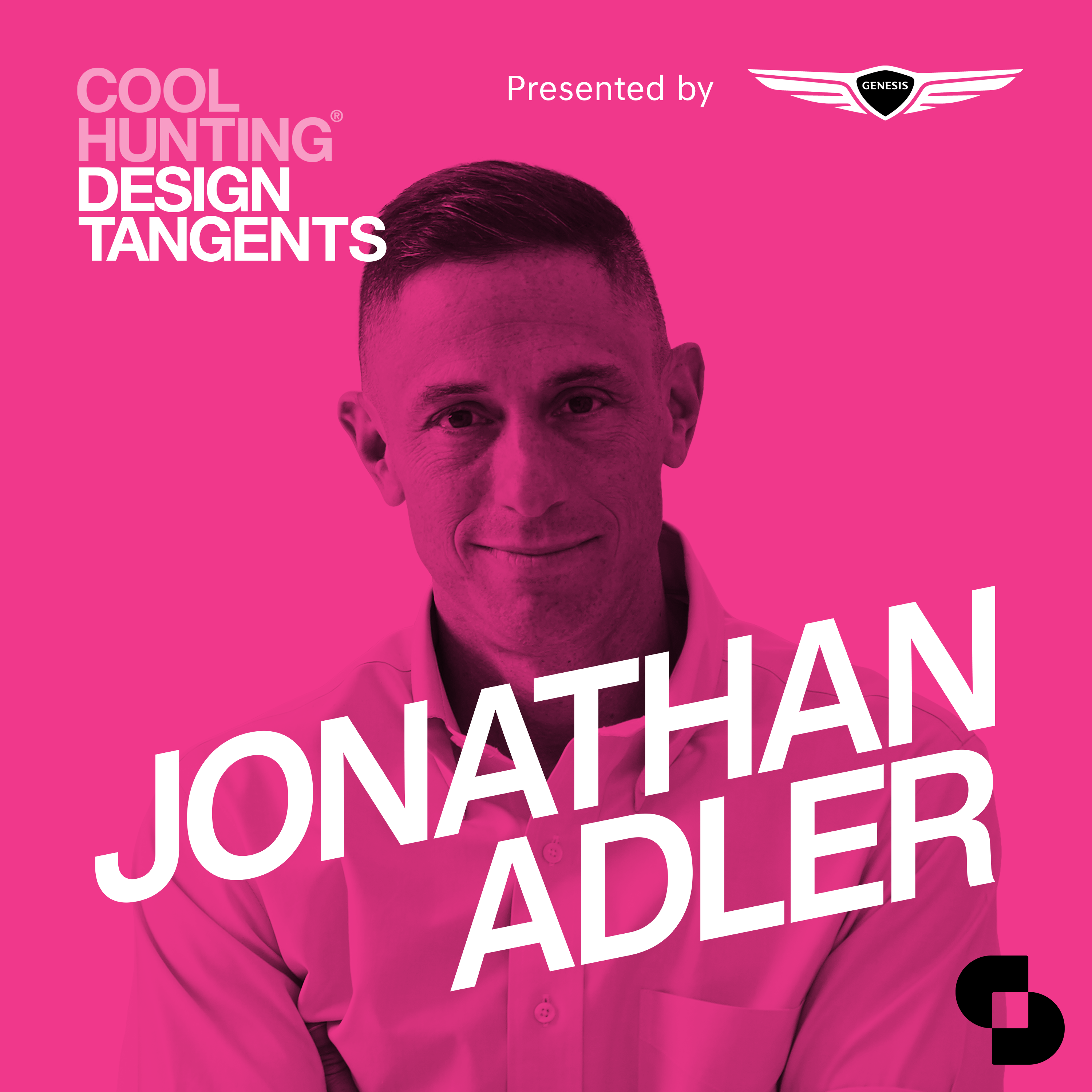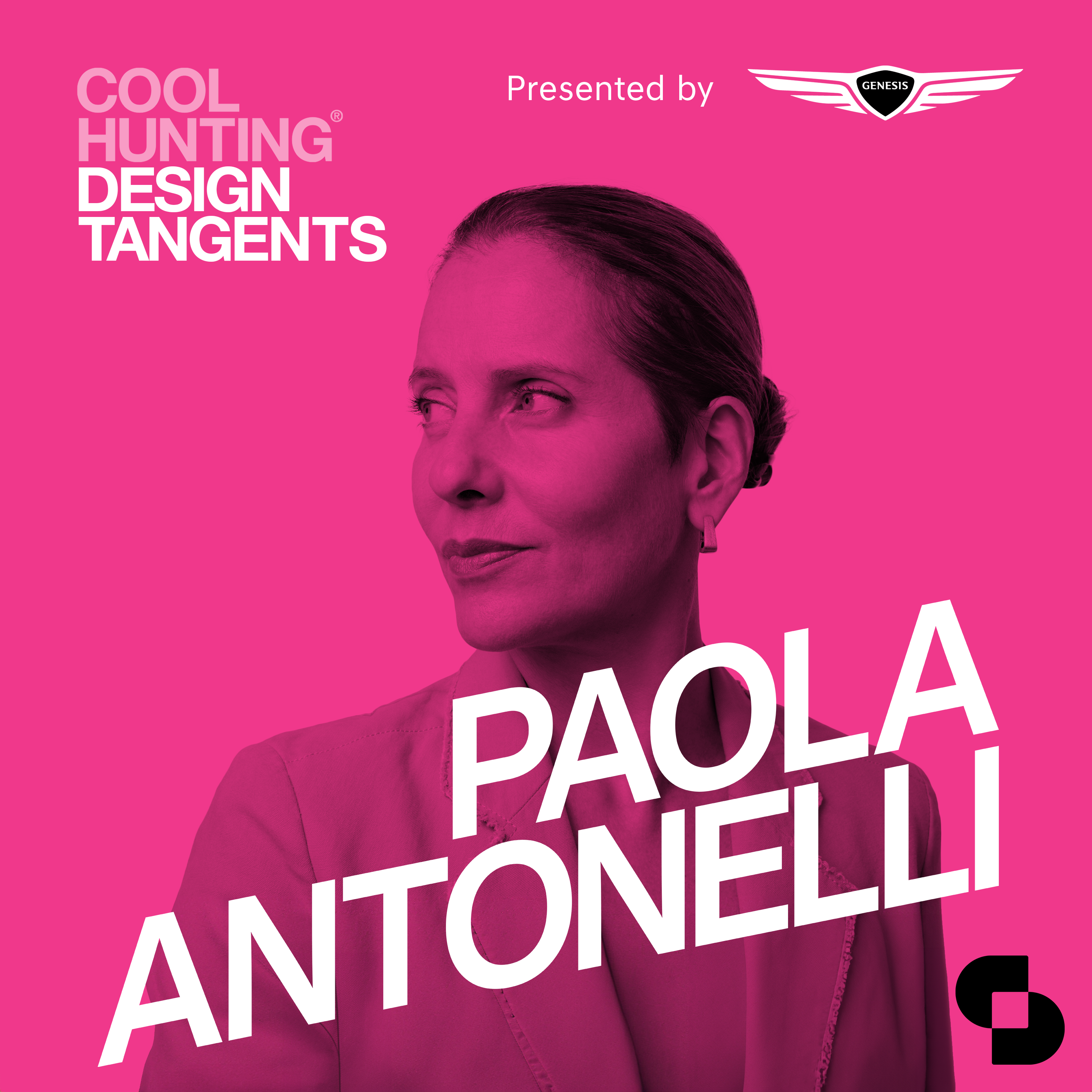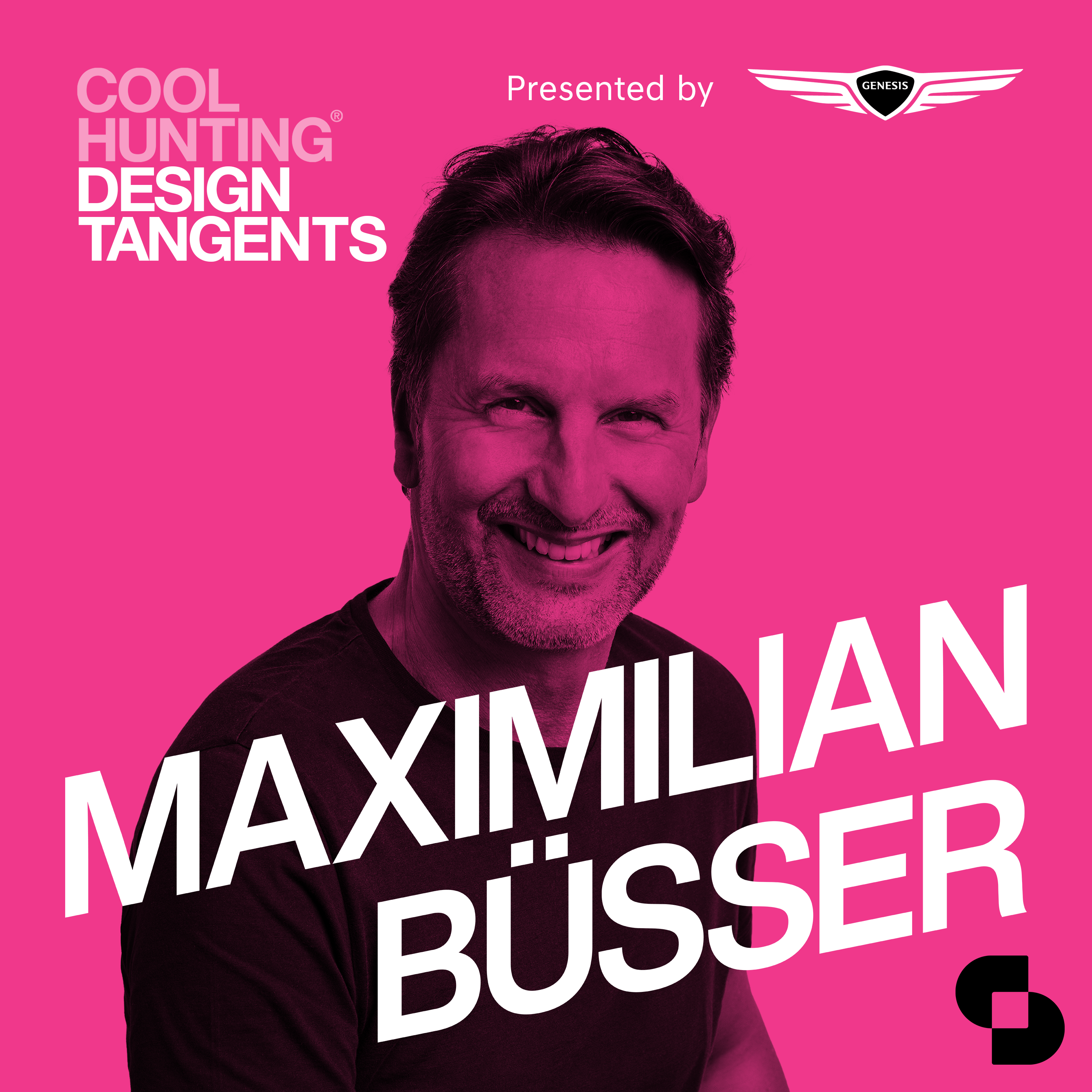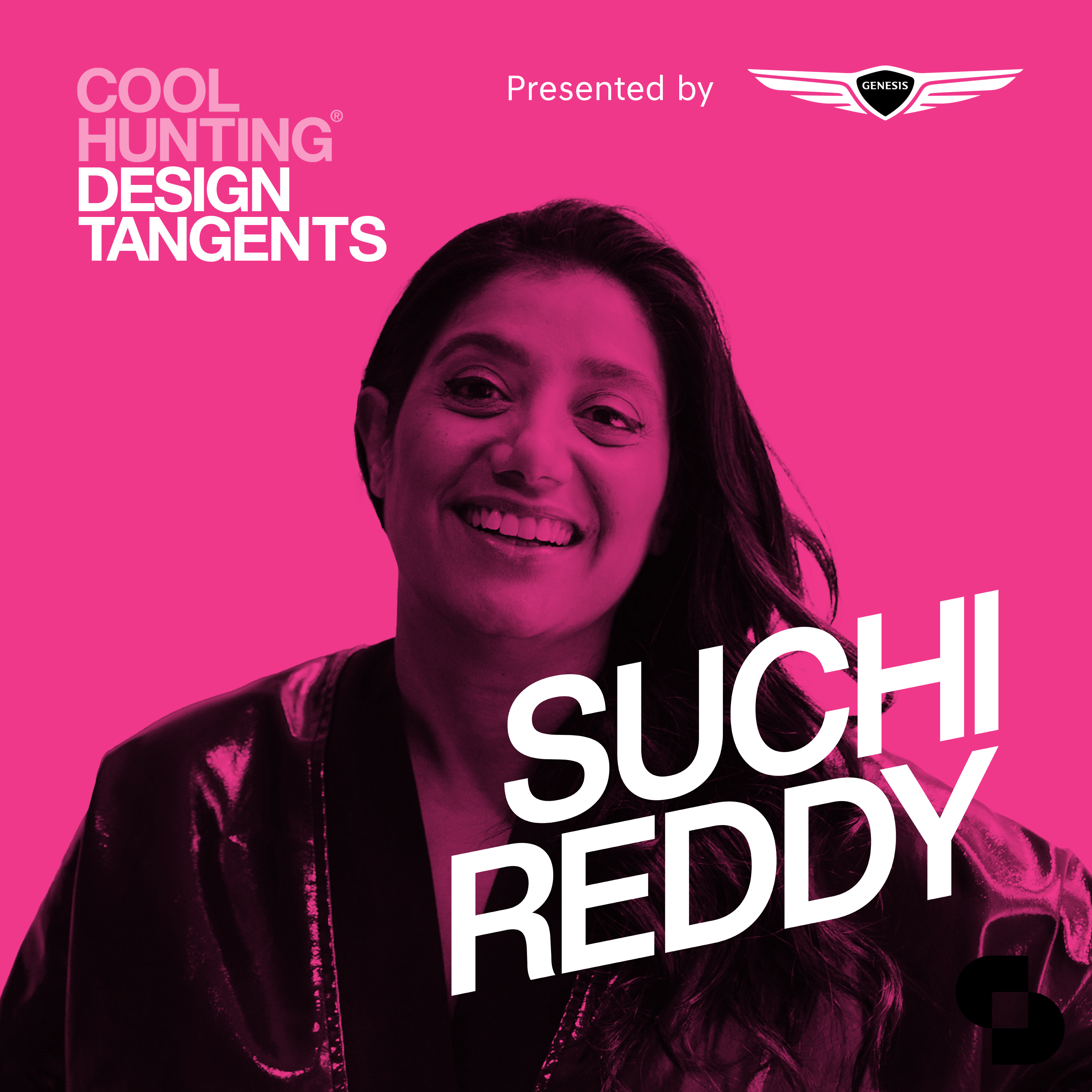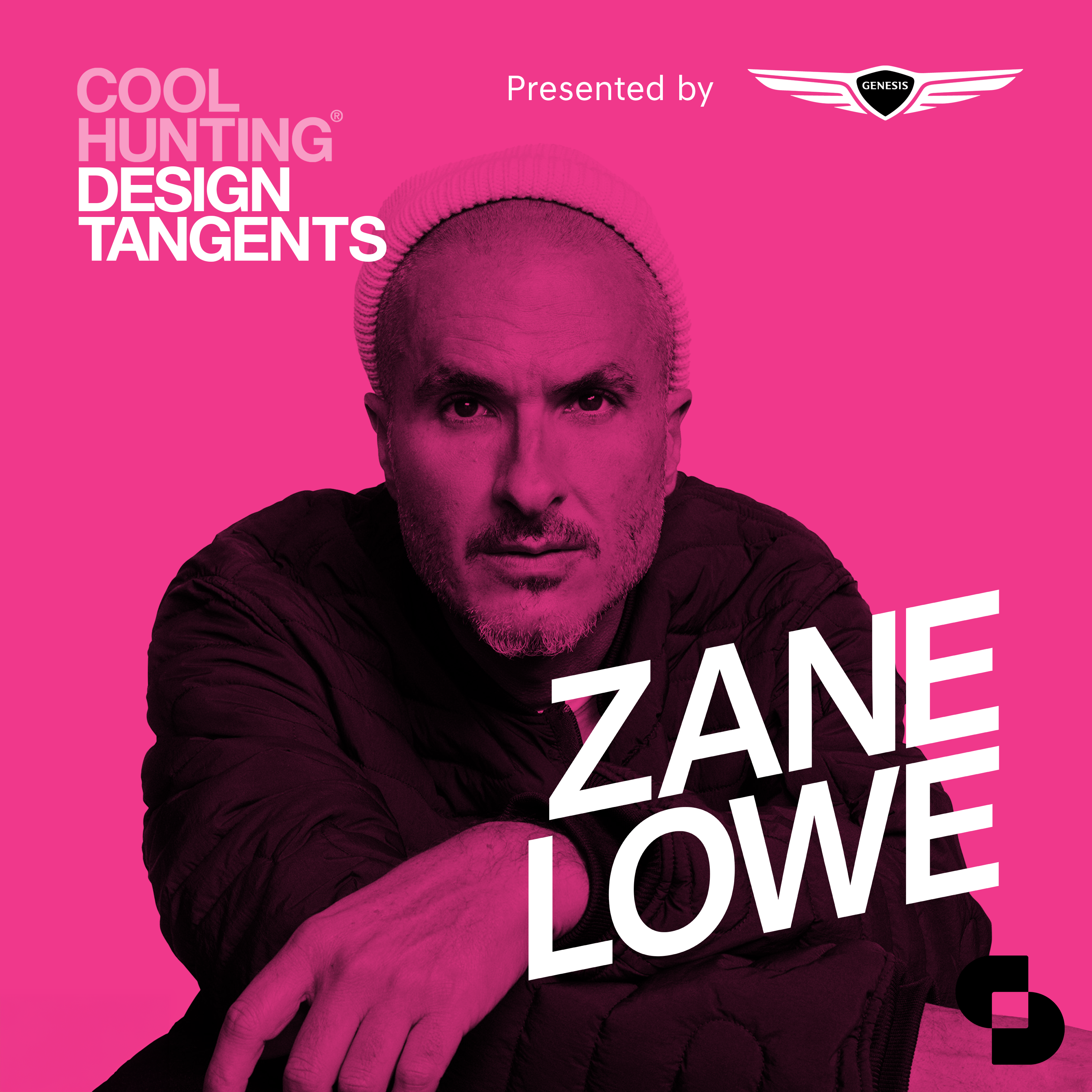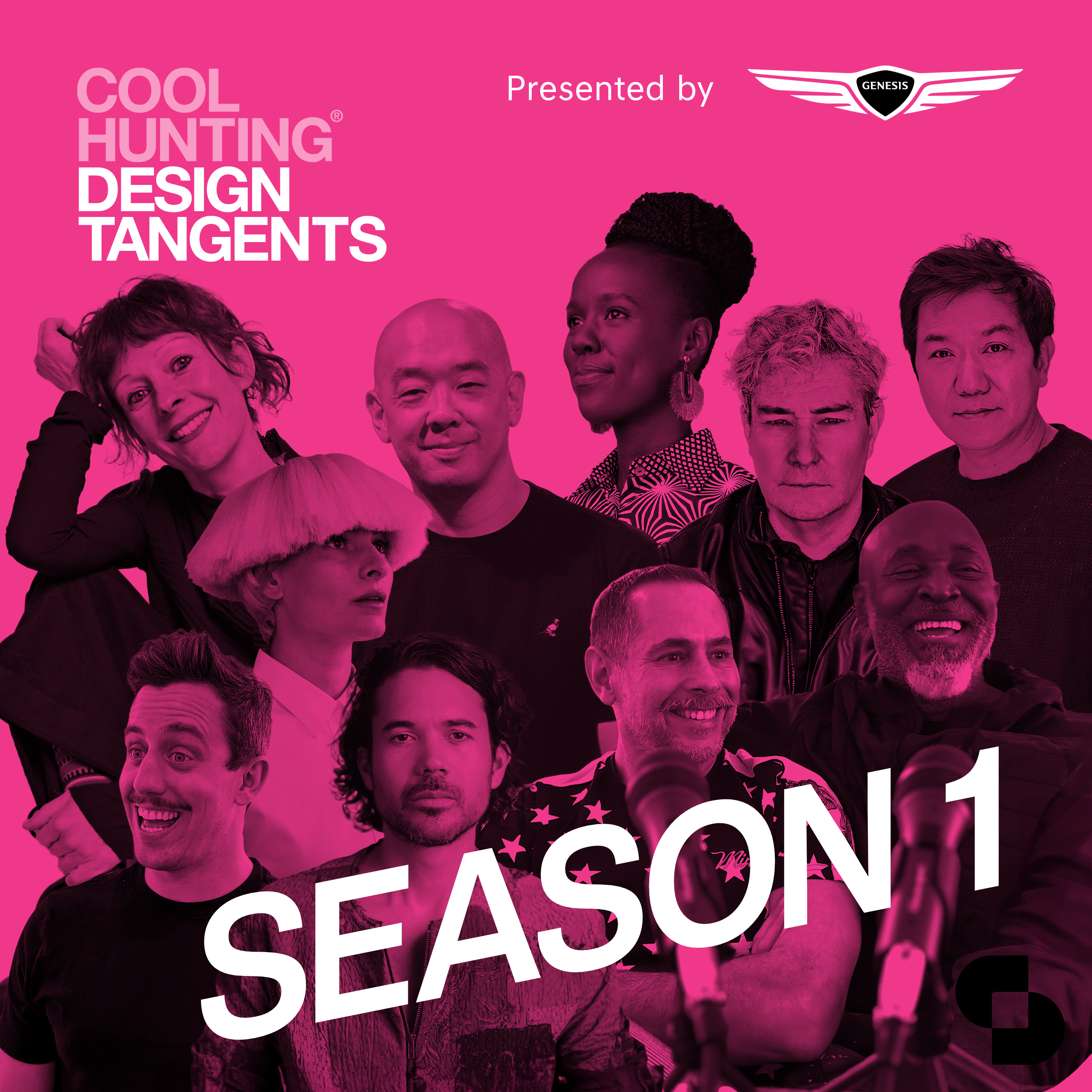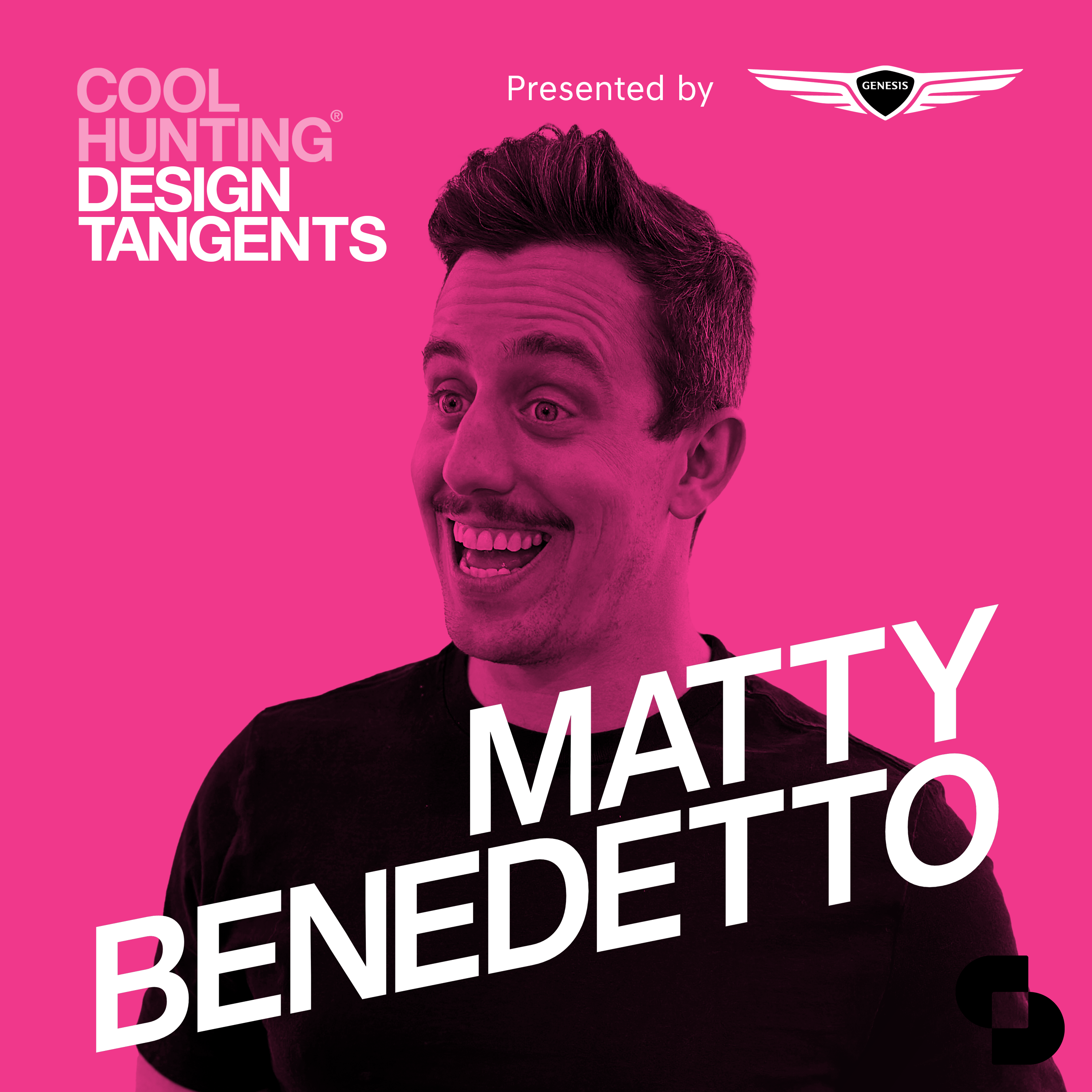It takes a certain kind of compatibility to be creative collaborators and for those who are life partners as well—like hosts and COOL HUNTING founders Josh and Evan—even more nuanced. That’s one of the reasons they were especially excited to visit artists Nick Cave and Bob Faust in their Chicago studio and home to dig into their respective creative process and the Venn diagram of their community activism, personal and joint work, and their private lives. In this episode you’ll hear how upcycled knitwear brought Nick and Bob together, how they support each other’s work, fostering community, developing projects that create an impact and toward the end, a fashion vision we all want to see manifest!
Bob Faust
Nick Cave
Facility (the space that houses the artists’ studios and public galleries)
Discover more shows from SURROUND at surroundpodcasts.com. This episode of Design Tangents was produced and edited by SANDOW Design Group.
Special thanks to the podcast production team: Rob Schulte, Hannah Viti, Wize Grazette, and Samantha Sager.
Transcripts, show notes, and links for each episode of Design Tangents can be found at surroundpodcasts.com/design-tangents
Although the transcription is largely accurate, in some cases it is incomplete or inaccurate due to inaudible passages or transcription errors.
[00:00:00] Bob Faust: You go first.
[00:00:07] Nick Cave: Why me?
[00:00:08] Bob Faust: Because you’re the artist with the big a.
[00:00:11] Nick Cave: Hi, I’m Nick Cave, artist.
[00:00:14] Bob Faust: Hi, I’m Bob Faust, and I’m the designer and artist.
[00:00:18] Nick Cave: And?,
[00:00:19] Bob Faust: mm-hmm, And!.
[00:00:22] Evan Orensten: Welcome to Design Tangents, a podcast that goes behind the scenes with creative change makers to learn about their work, inspiration, challenges, and philosophies.
[00:00:31] Josh Rubin: I’m Josh Rubin.
[00:00:32] Evan Orensten: I’m Evan Orensten.
[00:00:34] Josh Rubin: We’re the founders of Cool Hunting.
[00:00:36] Evan Orensten: One of the great things about our job, and I think Josh, you would agree, is that we get to meet so many incredible people, and many of them are heroes and true inspiration for us.
So being able to sit. With Nick Cave and Bob Faust was incredibly inspiring.
[00:00:50] Josh Rubin: Nick Cave has become a very well-known artist and we’re excited to dig into his work and his practice. We’re also really excited to [00:01:00] talk about the collaboration and partnership that he has with Bob Faust.
[00:01:04] Evan Orensten: Both Nick and Bob have separate practices as artists, but collaborate together and as a creative duo and couple.
We felt it would be rewarding to sit down and hear how they collaborate together and live together.
[00:01:16] Josh Rubin: While we were with Nick and Bob at their studio in Chicago, we got a sneak peek at some work in progress that won’t be presented to the public for a couple years. And that opportunity to see an artist’s process was a great reminder that the work we see in galleries and museums sometimes takes years to create.
[00:01:38] Evan Orensten: Was such a. It’s amazing and inspiring to see people work so hard on things that take so long to become visible.
[00:01:48] Josh Rubin: Today we’re in Chicago and it’s great to be back. Evan and I lives here briefly. Back in the early two thousands,
[00:01:55] Evan Orensten: Cool Hunting was created in our kitchen here in Chicago and Wicker Park. [00:02:00] Almost 20 years ago to the date.
[00:02:02] Josh Rubin: Right now we’re in the incredible creative space where artists, Nick Cave and Bob Foust live and work in Chicago’s Irving Park neighborhood.
[00:02:12] Evan Orensten: Nick, Bob, thank you so much for welcoming us to your amazing gallery. Community, space, studio, and Home. Have been a fan of your work since the sound suits, and Josh and I saw your show at MASS Moca back in 2016. It was not only a great immersion for us into your work, but also that work in that space is an incredible way in which it was installed and and experienced.
[00:02:39] Josh Rubin: As we’ve spent a little bit of time with you, Evan and I are sensing a bit of kindred spiritness. You’re a couple, like Evan and me, you have your own separate work and interests, but you also collaborate and work together among other things. In this episode, we want to dig into that Venn diagram. Of your creative collaboration, [00:03:00] what’s Nick’s?
What’s Bob’s? What’s yours together? But first, for some of our listeners who might not know who you are or what you do, can you share a little bit more
about your work?
[00:03:12] Nick Cave: So I am an artist, but I’ve never sort of taken ownership of why I do what I do. I’ve always sort of used it as. Way to bring us together is a way to talk about difficult, uh, subjects.
It has saved my life at the same time, you know, for me, art has always been this vehicle for change and, and it’s the place that I go to, to work through a lot of things. I’m fortunate to have such an amazing way of, uh, processing and delivering,
[00:03:56] Bob Faust: and I’m an artist and a designer, [00:04:00] designer by trade for the past 30 years.
And so when it moves over into that art space, I like to just say that the medium of that work is designed and where I’m coming from with that is, Almost always rooted in typography of some sort, whether it’s meant to be red, or the shapes are being used to imply a feeling or an emotion, and just giving you more context for whatever that idea is.
So you’ll see those bits and pieces throughout everything, whether you wanna categorize such as art or design and I think the other thing about my practice is that it’s generally. Either very minimalist or very maximalist. Um, yeah, maximalist or minimalist. I don’t really love that between space, but I really learned the between space of art and design.[00:05:00]
[00:05:00] Evan Orensten: We were able to spend a little bit of time with you before we sat down to record this, and we talked a little bit about the things you’re working on. So a book is coming out, a show that you’re working on that opens in two years. Installation that you just completed that anyone can see if you happen to be at the airport in Kansas City.
It’s called The Air Up There. But why don’t we start with kind of how you got there. Take us
back a little bit.
[00:05:20] Nick Cave: You know, I grew up looking at Michael Jackson and I looked at my mother one day and I said, I’m gonna be famous. I did know what, in what capacity or what, what that looked like, in terms of a sort of medium, but I just saw him and I saw myself.
[00:05:44] Bob Faust: That’s hilarious.
[00:05:45] Nick Cave: And then I just was, you know, honey in the hustle. And you know what that means? ups and downs, and went to art school, the Kansas City Art Institute, then went to Cranbrook for my masters. [00:06:00] I’m in Chicago because my professor and my closing meeting at Cranbrook said, oh, and by the way, you have a job, I think School of the Art Institute in Chicago.
That’s why I’m here and how I got here.
[00:06:13] Evan Orensten: Straight outta school.
[00:06:14] Nick Cave: Straight outta school.
But I’ve always been created, you know? And as a kid growing up with seven brothers, hand me downs. I was like, oh God, I can’t wear this shirt. So I’m cutting and putting things back together and reworking things. And so I didn’t know what that meant, but I all, I knew that it needed, I needed to sort of claim it as something else.
And so that was the beginning. But, you know, growing up in a sort of surrounding where, you know, I grew around maker. Woodworker painters. Uh, my mother comes from a family of 16. Amazing seamstresses. You know, I saw all of that but [00:07:00] wasn’t really doing it, but curious about it. That was really kind of this world that I sort of was rooted in.
You know, my grandmother would quilt. Dinner every night, and I just found comfort in sitting there with her. So that was really special. And I tend to do that when I’m in the studio with myself and just sort of completely in tune. But you know, I’ve always been sort of fearless. I just jump in. I don’t know where I’m gonna land, but I’m going to land somewhere somehow.
That’s just part of my sort of nature of always being willing to risk it. I think if I don’t have the risk, then I’m bored or I, I sort of move on to something else. It has to have. [00:08:00] Sensibility of, of the unknown, like this new body of work. I, I see it, but I don’t know it. I’m gambling, but that’s just how I play.
[00:08:12] Evan Orensten: Bob, are you similarly loose like that, or are you, is your kind
[00:08:18] Bob Faust: of probably not quite as loose as that at the end of the day, but like I was listening to your story and I’m thinking to myself, it, it’s, there are similarities in that young part. When I was in grade school, I was always been kind of a, not a quiet sounding kid, but a quiet kid in terms of like popularity, quiet, like to myself.
And my parents would always, on Fridays and Saturday nights play poker downstairs. I’d be home by myself and they’ve always given me kind of carte blanche, whatever my room was. And I know that those evenings I would just go up there with a gallon of. and I would change the color of the room, move the room around, and then they’d all come up [00:09:00] cuz they played until midnight and then they’d go once around the table.
So I was always done at around one in the morning, they’d all come up to see what I did in that room. It would be a totally different color or a new wall would be painted like kind of murally. Or as I got older, I started to take the sheets off the bed, paint the sheets, and then hang the sheets so I could have like a living room and a, you know, a bedroom or a little studio.
So I was always doing that. So in, in a way that freedom, that like your four walls of your bedroom be whatever you want, was a really lucky way to grow up to know that creativity not only is yours to do what you want with, but also they, these, you know, other parents, uncles, aunts, they were all coming up and being excited about it.
They weren’t mad about it, they didn’t necessarily love it, but. Loved that I was just busying myself and making something. So I do think that I always knew I was gonna do something [00:10:00] creative, but it took a bit because back in the day, high schools didn’t necessarily teach you about creative pursuits, and in fact, they didn’t even tell you that you.
Hundreds of college choices. They told you you had these three. If your grades met this level, you go to U of I. If they’re at this level, you go to another school and if they met this level, you go to a third. And so I didn’t even know graphic design existed until a year of college.
[00:10:30] Evan Orensten: And you were drawn to it.
[00:10:31] Bob Faust: Totally. I knew that there was some kind of way to make money was creativity. And I had an inkling, it was in advertising in college. That was the closest I came. Understanding how you make money being creative. And so once I got to school and started to look around, the fine, the fine arts were more interesting.
And then you saw that, oh, there’s professional pursuits within the fine arts, but I had to find that. And so, you know, [00:11:00] you kind of start over as a sophomore.
[00:11:02] Evan Orensten: So you did not have six or seven brothers or sisters.
[00:11:06] Bob Faust: No, but similarly, one generation back, my grandmother’s the oldest of 20, so she raised most of her siblings.
And when she got married at 16, my mom was older than several of her aunts and uncles and would babysit her aunts and uncles. So our family is like this gigantic bat Italian American clan from the west side of. ,
[00:11:33] Evan Orensten: your great-grandmother.
[00:11:34] Bob Faust: Yeah.
[00:11:34] Evan Orensten: Had 20
[00:11:35] Bob Faust: Yeah.
[00:11:36] Evan Orensten: Children.
[00:11:37] Bob Faust: And if you’re a, like a kind of an introverted kid, you don’t go out of your way to necessarily make all those relationships.
[00:11:45] Josh Rubin: So when and where did y’all meet?
[00:11:47] Bob Faust: Starts off that Nick was trying to make rent, so he had to have a sweater sale, but a mutual friend of ours invited me to the sweater sale. He’s like, you’re gonna really love what this guy’s making. [00:12:00] and I show up. You’re met with this, like, oh, there’s three people here, and a whole bunch of sweaters, and I’m going to be leaving with the sweater.
You have no choice when you walk in that door, so I start flipping through the sweaters on the rack, getting ahold of myself because this is Nick Caves sweaters. . And as you can imagine, they’re not a typical sweater, and I’m a pretty typical guy at that time, right? So I’m flipping through one arm’s longer than the other.
There’s a hole in the chest. There might be like a baby sweater sewn onto the front of an adult sweater, and I’m like, I, I can’t, I, I can’t any of these sweaters. And I’m not even looking at the pricing yet, right? And then I find a brown, one little mock turtle neck, like I think I could do the brown mock turtle neck.
And then I see that the arms are long, but I can manage long arms. So I grab that one and I’m ready to run out the door. He stops me and he says, why don’t you go try that on in the office, your office [00:13:00] at the time. So I said, okay, go into the office and try on the sweater. And all of a sudden he comes in.
A stack of sweaters to
try on.
[00:13:08] Nick Cave: Look, you could wear, like if I was designing sort with someone that would, had been for him in terms of body type and just, you know, you could put on anything and it just looked amazing.
[00:13:25] Bob Faust: But back
in the day, you know, like J Crew was the thing. Banana Republic was cool. I can’t even imagine , but that’s what I wa was wearing.
So this was crazy to me. Anyway, I put ’em on, it was really fun. That took down all of the nerves and we just start talking. He’s like, what do you do? And I’m like, I’m a designer. My studio’s just, you know, four blocks down the street and this
[00:13:52] Evan Orensten: Here in Chicago?
[00:13:53] Bob Faust: Yeah. And the, and the South Loop. This is back before the South Loop was the.
anyway. What do [00:14:00] you do? I’m a designer. What do you do? You gotta do something more than make sweaters. You know? These aren’t in the store. It’s like, well, I teach, but I also am an artist and I have this solo exhibition where I get to make my first catalog and I’m like, aha, this is super cool.
[00:14:16] Josh Rubin: Biz dev.
Yeah.
Yeah. You’re like, oh, I can make
that catalog.
[00:14:19] Bob Faust: And I’m thinking, I can do a trade here. I don’t have to pay for the sweater.
[00:14:24] Nick Cave: Honey. No.
[00:14:25] Bob Faust: So I said,
I said,
[00:14:26] Nick Cave: we’re not having it… rent! ,
[00:14:30] Bob Faust: but I said, if, why don’t you come down to my studio tomorrow, and if you’re interested in what I do, maybe we can do this project together.
[00:14:38] Josh Rubin: Was there a
[00:14:38] Evan Orensten: vibe? Yeah. Was
there a vibe?
[00:14:40] Bob Faust: Hmm. I think I told you guys this. I, I didn’t come out till I was 42. 43 years old, so this is a whole nother podcast, this story. But the person I was at that time was unable to acknowledge that vibe. So [00:15:00] while today I could answer your question, yes, there was a vibe at that time, it was another one of those uncomfortable feelings that I had to shove away.
So there was not a vibe to act. , but there was an acknowledgement that I liked this human.
[00:15:17] Nick Cave: There was, it was not a vibe dno, but there was a vibe and
[00:15:20] Josh Rubin: clearly it was the start of something.
[00:15:22] Bob Faust: . Well, I’ll tell you, this is the, the coolest part about how this all started is that he came over, I showed him a few things.
He’s like, oh yeah, you can do this project now. Here’s what I want. I don’t want a book, I want an object. And that was just like, That was the coolest prompt I’ve ever gotten for a professional project. I want this thing that has definitions around it, but I want it to be this thing that has other definitions.
And I was like, I, you couldn’t have given me a better, um, the thing I love most about design [00:16:00] are parameters. And now you just gave me two sets of per. That kind of don’t overlap at all, and I gotta solve it. It was
awesome.
[00:16:09] Nick Cave: Yes. The sweater sale, yes. I needed to rent. Yes, you were gonna buy a sweater. I mean, that’s just how it works.
But when we connected in terms of like knowing that he was this designer, I was like, well, let’s sort of see. And so for me it was like everything else, I don’t want a book. I want an object, you know? That’s all I know. I don’t know what that means in terms of how that may be as as, as it ticks form and shape.
[00:16:41] Bob Faust: That’s the other cool thing of working with you..
[00:16:42] Nick Cave: But I was very interested in sort of like the process of that. Like how do we get there? I don’t, we figure that out. And I looked at his other work in Ian sort of knew right away he could do it
[00:16:57] Evan Orensten: and you wanted him to do.
[00:16:58] Nick Cave: Oh yeah,
[00:16:59] Evan Orensten: it’s just convenient. [00:17:00]
[00:17:00] Nick Cave: It was, it was convenient. Oh,
[00:17:03] Evan Orensten: serendipitous
[00:17:04] Nick Cave: first, because I just had not like even started to really like dive into that, but I’m like, you’re four blocks away.
I mean, like, I can come open and
[00:17:13] Bob Faust: kinda sounds terrible, .
[00:17:15] Nick Cave: Check it out and see what’s going on. It’s not terrible.
[00:17:17] Bob Faust: It’s sounds terrible.
[00:17:18] Nick Cave: You know, opportunities come together like that. You know, you’re napping over when you. You were ready and I was ready. So it happened.
[00:17:27] Josh Rubin: Do you have
that catalog?
[00:17:29] Bob Faust: Yes.
This was a book and the idea to turn it into an object was that there was no binding in the book. And just like his work that’s assembled from multiple and many, many objects, the idea was to design the book so that it was delivered to you in a certain order in a certain way, and four different signatures that were categor.
like anyone would design a book in a really coherent way, but that if he was to visit that collector 20 years [00:18:00] from that day, it would be reassembled because someone opened it and it shifted and it would be reassembled, and no matter what order it was put back together, it would all make sense. The covers were just four pieces of cardboard.
Each of them printed with a different pattern so that covers could go together in all different ways as. And we were so happy with the process of doing it that we made a project every year for the next five or six years to be working on together. So that’s how we can establish a relationship. It was a working relationship that then became a friendship that later turned into literally a business relationship where we started a business together and then a relationship relat.
[00:18:53] Break 1
[00:18:53] Evan Orensten: Let’s fast forward a little bit. A lot has happened, and if I had to describe you both, I would say you’re a very [00:19:00] multihyphenate, you do lots of things. You’re both creatives, but that’s expressed through art. It’s expressed through designs, expressed through installation and books, renovating this incredible space that you have.
It’s starting a non-profit. It is being super engaged with your community. There are lots and lots and lots of things that have. in that time, I think you’re still hustling. As you said, it’s always about the hustle. The hustle never stops, but it’s certainly taken a different turn and this year there’s a lot happening for your work separately and together there are four simultaneous shows plus an installation you just did last week.
That one in Kansas City. There’s five active things that have just gone up. There’s this incredible line of materials that have just launched with Knoll, but. There’s
a lot.
[00:19:46] Bob Faust: It’s funny. There’s always a lot so like it, it doesn’t feel overwhelming right now. Sometimes it feels overwhelming, right? It feels
okay.
[00:19:56] Nick Cave: Yeah, it feels okay.
It’s always a lot of things going on, a [00:20:00] lot of projects in the works, but it’s really just sort of keeping a clear calendar of what’s in the forefront as opposed to what’s four or five years down the road. I’m not interested in working under stress, under pressure.. I know what that calendar looks like. I know how the studio has to function in order for us to get everything done.
We never work over time, you know, and that’s just because I really am interested in just being in the moment and present. And for me, the process is really, really important. I’m not one for sketching a lot, as opposed to. Spending a great deal of time thinking and working through it before I really even start to communicate about it.
It takes some minutes for me to sort of gather all of that and, and, uh, get real clear [00:21:00] and I tend to just be quiet a lot in order to, to have an understanding. And so, although, you know, as you were mentioning, all of the sort of things happening right now in terms of quality, it’s always very hot. That’s just the standard.
So that’s not even something that needs to be worked out. It’s just is. That is what it is. And so there are these sort of moments working with Bob on some of the work. The standards there, I don’t have to think about it. We just work at that level. The studio production, it’s just there. So that makes, it makes up for a lot of tar.
when we are clear, when we know what the vision is and everything just sort of falls into place. Cuz if I’m stressed out and this, [00:22:00] and then the studio’s stressed out and it’s just, you know, it’s just not the environment that I’m, that I want to be yet Ever.
[00:22:08] Bob Faust: You Yeah, I think I, I, I like everything that you’re saying and I think that a lot of times the quiet and the prepar.
For when you actually start to activate on an idea. The amount of productivity is kind of unreal because it is just one thing. I think in the world today, most people aren’t operating from a single. I’m focused on one thing. Everybody’s like multitasking all the time, and with you and your practice, while there might be many things going on at one time, it’s clearly, I’m on this right.
Or I’m on this right now or I’m on this right now. And so those advances are super significant and less time and they’re clear. So it’s not as [00:23:00] iterative as maybe I work when the decision happens. That’s the object. It’s pretty interesting.
[00:23:08] Evan Orensten: Timelines are different cuz we’re, what we’re seeing now, you worked on years ago leading up to this point.
For some of these things, right? You have a show, you gave us the great special treat of a very sneak preview of work you’re working on for a show two years from now, right? It’s just the very beginning of that journey. But when we’d look at Furthermore, which was at the Museum of Contemporary Art in Chicago before it just went to the Guggenheim largely, that’s work that’s done in the past and it’s assembled, put together for that show.
But there’s, there’s kind of interesting time. Crisscrossing.
[00:23:42] Nick Cave: You know, it’s
really the task at hand. It’s like I’m thinking about Knoll, I’m thinking about like the M C A show. I may have to jump on the plane and go to New York. I’m transitioning the mind. I just sort of turned it off over here, [00:24:00] turning on over here.
Just sort of like this navigation that I’ve always done. But again, there’s a standard. , regardless if it’s my personal art artwork or if I’m collaborating with a corporation or collaborating with Bob on a project, or if we’re doing something for Facility. It’s the standard that guides everything aesthetically, just hence to we.
I cannot put anything out there unless it meets.
[00:24:34] Josh Rubin: I love
your ability to be able to turn one thing off and turn the next thing on. Pretty remarkable. Bob, you talked about, not earlier in this conversation, but previously you’ve
talked about yoga and running and
nature and the ocean. Are those influences that
you use or that help you find
focus and help you kind of
[00:25:00] pursue direction or change direct?
[00:25:02] Bob Faust: Yeah, without question. It’s those, all of those places, either in it or directly after it, where the creative ideas come from me because my day-to-day work is quite different than his, because I’m doing my own work, of course, but I’m also doing my work that’s with or for him, but also managing. All the projects along the way.
So I kind of look at like once nine o’clock hits. I don’t wanna say it’s administrative brain, but it is splintered brain all day long. All day long. And so in order to get good work to come out, whether it’s for me or for you, or for us or for someone else, I have to have that solid chunk. Mind time that switches it and yoga’s awesome for it.[00:26:00]
Running is fantastic for it, but so was just looking at the lake
[00:26:04] Josh Rubin: among the merch that you all have made.
For some of the exhibitions
there are yoga mats.
[00:26:11] Bob Faust: Mm-hmm.
[00:26:12] Josh Rubin: hearing all of this, it takes on a whole other. Level.
[00:26:17] Bob Faust: So a really fun part about the yoga mat is they weren’t easy to produce cuz they’re a hard thing to sell cuz they’re a high dollar amount.
And we found the opportunity to make them at Expo. And so we did a, a collaboration, a project with 21 C art hotels and they wanted us to design the booth for 21 C. And yeah, we can design the booth, but that also wasn’t super interesting to just design a booth , you know, he’s got a, a booth with all his arts already.
Like Everett sang right there. We’re like, we could make this a really fun opportunity. We talked to them about their commitment to each local community that they go [00:27:00] into, and they were about to move into Chicago. And so we said, well, let’s just make your booth not about showing off 21 C as an art hotel, but show you off as a community member.
So we made that booth into a. Where if you went in there, you can have your tarot card read or your energy read, and we made wallpapers that you can cut off and take for free so that can change your own environment. And yoga mats that we actually did a whole class for anyone at Expo in all their clothes, buy the yoga mat, have the free class.
And so we got to make our yoga mats, but we also got to make them with a bit of. Play, but engagement and that project became something really fun and worse putting a lot of energy toward, as opposed to just designing a booth for four days.
[00:27:56] Evan Orensten: I, I love this idea, like important markers in time and, and you talked [00:28:00] about your first encounter, a pivotal moment was paying your rent out and you had a means to do that.
You were gonna ha. Friends and friends and friends over to buy sweaters and you made your rent, and that’s a pivotal moment that month. That was probably an incredible high, like yes, I, you never said that you paid your rent, but I’m assuming you actually rose that was raised the
money to do it.
[00:28:20] Nick Cave: oh! , I paid my rent for four or five months,
[00:28:23] Evan Orensten: so in that moment, that was extremely pivotal.
[00:28:25] Nick Cave: It was pivotal in that moment, but it also told me a lot about possibility in terms of like, oh, Could I be a, a fashion designer? These moments where you’re like scene results, seeing how the, getting feedback, you sort of learn about what you’re doing. So, you know, just should I, light bulb comes on, like, oh, like, hmm, should I, or should I not pursue that?
And if I wasn’t an artist, I would certainly be a designer, fashion [00:29:00] designer. For sure. Hands down. Cotour..
[00:29:02] Bob Faust: I’d be a plastic surgeon. ,
[00:29:04] Evan Orensten: plastic surgeon.
[00:29:05] Bob Faust: Yeah. Yeah, totally. We might have a TV show too. Total TV show, plastic surgeon.
[00:29:11] Josh Rubin: Okay. We’ve, we’ve got like multiple podcasts, right? We have a lot that are gonna brand off of this.
Like this isn’t just about little tangents, like we’re going city tangents with the tangents. I love it
[00:29:21] Evan Orensten: stay tuned for a whole new podcast coming your way.
[00:29:29] Break 2
[00:29:29] Nick Cave: I think mass Mocha was a pivotal moment. You know, Denise Markonish, the curator that I was working with there, you know, she came to the c d and she was like, you, I’m interested in you doing a project in, in, in Gallery five. And uh,
[00:29:48] Evan Orensten: when was that?
[00:29:48] Nick Cave: She came maybe 2014. And she goes, I’m going to go away and come back in the year.
And she goes, only one [00:30:00] ion, you can’t do sound suits. And I was like, yes,
[00:30:04] Evan Orensten: because you’d produced that body at work. And it was quite popular.
[00:30:09] Nick Cave: And I was at that moment where I was like, eh. Trying to sort of like phase out of that. So it was,
[00:30:16] Bob Faust: building five is also a football field in size. Yeah. Like it sounds, it.
Minuscule morphed
in it.
[00:30:22] Evan Orensten: Yeah. For those that don’t know, I mean, mass smoke is an incredible place and hopefully you are the opportunity to, to go and visit them, encourage you do so, and, and Gallery five is, is literally a football field space with enormous ceilings and you really have to create things intentionally for that volume of space.
You can’t just place. Existing things cuz they just get swallowed up by it. Yeah. Had you seen other exhibitions in that space?
[00:30:47] Nick Cave: A number of exhibitions in that space, but I’d never been in the space empty and so I told Denise, when it’s empty, let me know so I can fly out. Because what I tend to do, like when I [00:31:00] have these sort of amazing opportunities such as Mass MoCa is I tend to go there and I have to surrender.
Body, myself, over, to that space. We went there and I just laid in the middle of the space and just took it in. Hadn’t decided what I was going to do, and then came back and you know, I wasn’t really thinking about it, you know, I just was sort of like, I don’t know. So happened. And then Michael Brown happened and I had a pivotal moment.
In the studio because as I was listening to that incident, this idea of is a racism in heaven came to mind, and that was the catalyst that sort of started next project. The only thing that I knew is that I wanted to put you into the [00:32:00] belly of a sound suit. And what that means is instead of it’s concealing, I wanted to then expose what is really behind the work.
And so that space allowed me to do that. The thrill was so exciting and I had to fucking pull it off . So that’s how the Crystal Cloud scape was created, asking the question, it’s a racism in heaven. And so I knew that that was going to be the heart. Of the space that just led down this sort of path, thinking about the reoccurring incidents of harm on black bodies saying, yet we are viewing it from our TVs, and yet it’s right in our backyards.
And so then that led to the wind spinner. Then that became this fantastical object that created this kinetic forest. [00:33:00] That as you walk into that space, you were just in the space of wonder at all. And then as you got closer to the spinners, and as you saw guns, bullets, you know, I was interested in that punch in the stomach at the same time.
And so forcing the viewer to sort of like, okay, grappling with these emotions, like, what, what am I supposed to do with this? You know, I feel this way, but yet I’m experiencing. This. And so that’s how that whole project came about. And then there was this amazing programming aspect of, of the project, how did I want it to be used?
And so that was just fabulous in itself. And then this is where I asked Bob to participate in doing a number of wall works. That supported
the exhibition.
[00:33:58] Bob Faust: Yeah. That was an [00:34:00] incredibly generous and also fortunate place to be, to push my work to a whole different level because it’s yes, absolutely in support of his work, but it also is its own thing inside of, uh, art space.
And this art space was going to accept this work because of this relationship. So there is so, It’s, that’s such an important ask and moment for me. Now, I’ll say Denise was in support of it the whole time, so it never had any kind of feeling of pushback at all. But I don’t know that that kind of opportunity would’ve ever arose for me without me being adjacent to you and the work.
So it’s, it’s a very grateful place to be. Um, but similar to the prompt. That first book where it’s [00:35:00] a broad ask without much specificity, that was the same for these walls. And these walls were not a title wall like you’d typically put text stuff on and read the didactic and how to set the stage for what you’re about to look at.
It was something to literally support the work inside the. and so I took that main wall as an opportunity to it. It’s the wall you see when you walk out of the exhibition as opposed to the wall you see when you walk into, so I used it as an opportunity to say, I know that this experience was probably about a 45 minute experience for the typical goer.
They’re seeing wind spinners and reflective floor surfaces, and they climbed 40 foot ladders to get on. This Crystal Cloud scape, and it’s loaded with thousands of objects that Nick has sourced in order to get across this idea of [00:36:00] is there racism in heaven? And then you’re gonna go through a 12 channel video room that’s gonna overwhelm you with like emotion and feeling.
And then you’re gonna walk through this like Mylar curtain that is gonna wash you of all of those feelings. And so what does this wall need to do at the end of all? in My intent was that as they’re walking out, remind them of little bits of what they just saw because all of that was so much. And so how do I make sure that I support his work by helping them tell their story to their friend at the dinner table the next day is remind him of some of those tiny things that were in the cloud.
Remind of what it felt like to be. Worrying installation of video, remind them of the guns that instigated the entire project and the lives that were lost. And so that was no longer graphic design. [00:37:00] That was my way of, um, making an an artwork, um, with all the tools I know how to use. It’s
[00:37:07] Evan Orensten: a pretty major event.
What, what does that feel like?
[00:37:09] Nick Cave: It was so calming. . If I could live in a space like that, I would
[00:37:18] Bob Faust: in eight sea containers on Mass MoCa’s parking lot, it’s Mass MoCa. Yeah. Like they engineered it and built it all. The structure, the infrastructure, the steel work themselves and like as Nick’s building that crystal cloud scape that heaven on.
He’s literally holding a piece of rebar and saying, okay, spot weld it here. This is where it needs to go. Now it needs to hold a bird that’s 12 feet or 12 inches tall, and its space is shaped like this, and they’re going back to the studio, cutting that, attaching it, and he’s putting it in. This is not like any normal art making process I’ve ever seen, [00:38:00] and in the midst of it, that was the other super cool part is.
If you could imagine, we just told you the whole story about, it’s always one subject, one time tunnel vision. The most incredible thing happened. So you were there the whole time, but I was there the last eight weeks, and so that last eight weeks is, you know what it’s gonna look like, but there’s a lot to do.
And the curator from the Park Avenue Armory shows up, can I get a meeting? I’m like, I don’t think you should have a meeting right now. No. So he comes down while we’re putting this thing together and he has the nerve to say, will you do a project at the Park Avenue New Armory in the middle of all this?
It was such an incredible ask, and all you can think about is that space is bigger than this one. What could it possibly be? And it’s the most minimal [00:39:00] project that he’s ever made. So like that was just, yeah, I so
incredible.
[00:39:04] Nick Cave: Yeah, I had to completely like decompress. I could, I just thought it’s going to be one object period
there, one material.
[00:39:15] Bob Faust: And if, Mass MoCa is like going into the belly of the sound suit, Park Avenue Armory was like taking a macro lens on the edge of Tina Turner’s skirt and that’s all it was one
thing.
[00:39:27] Nick Cave: These opportunities, these are all. Colliding cross crossing past intersecting, but I just remained open to possibilities.
Not that I’m gonna say yes, but I’m like, okay, let me think about it. Because at the end of the day, this is where we’re at right now. This is what the focus is and, but it was really quite fabulous working there, mass smoker and just seeing it come to fruition and just sort of, , you know, you [00:40:00] think one, one strand of spinners that are like, how many per
strand?
[00:40:06] Bob Faust: Oh, that was a long one. Those were 40 feet. So you know, probably like
15, 20.
[00:40:11] Nick Cave: And you think we have to fill this entire space, with that. And I think another pivotal moment was AMENDS.
[00:40:19] Evan Orensten: Tell us about AMENDS.
[00:40:21] Nick Cave: I was at home when George Floyd happened at my mother’s. and I just was like, oh, you know, it’s just too much.
You know, you just, it’s just like a lot. My mother could tell that I was like just on edge and I was like, I gotta go home. Uh, I knew that I needed to get back here to Chicago cause I knew that I needed to respond and, and Bob was here and so I left my mother, my visit with her early and came back. Like getting in the house.
They had just come from,
[00:40:58] Bob Faust: we came back from a [00:41:00] rally.
[00:41:00] Nick Cave: A rally, and I was like literally like emotionally like just going through it. And he says to me, oh, we just came back from this amazing rally.
[00:41:11] Bob Faust: We felt like we just were part of some positive movement because we had walked for six hours. and we were gonna share how strong that feeling was there.
But I think we also felt like we did something more than we did . We just walked.
[00:41:33] Nick Cave: I was like so furious and just so on the edge. I said, well, if you’re gonna march about it, you gotta talk about it. Yeah. And that’s what led this.
[00:41:44] Josh Rubin: and that statement was the, the most bold of all the text that was in the windows
of that piece, right?
[00:41:52] Nick Cave: Yeah. Yeah. And so then we were like, we have to like say something now we have to [00:42:00] use Facility this. That was the first time I understood why we had the building.
[00:42:07] Evan Orensten: And by the building you mean your.
[00:42:08] Nick Cave: Facility.
[00:42:10] Josh Rubin: The building that we’re in
right now, where you, where you live and where you work, where there are windows
out to the street and you use them to display work and you rotate work and you provoke conversation and you engage. Community
[00:42:27] Evan Orensten: Facility is is the name of this space, but it’s also like a multi. Purpose, not much purpose, but a multi-dimensional word.
[00:42:36] Nick Cave: Mm-hmm. ,
[00:42:37] Evan Orensten: it means a lot more than just the name of the building.
[00:42:39] Bob Faust: That’s the most important thing when we’re titling an exhibition, is that it has multiple reads. Like UNTIL that started out as guilty until proven innocent, that was gonna be the title, and then it was innocent until proven guilty, and then it was some other hyphenate, and then it went down to UNTIL.
[00:43:00] Which got all the way back to until what? Until everything changes, and so you’ll see that in every single title
[00:43:09] Josh Rubin: Today. What is Facility here to do?
[00:43:13] Bob Faust: Facility is here to give opportunity or encouragement or access to young creatives, any discipline to pursue that path. There are so many examples that are so simple.
Of ways that you can encourage someone to take a step toward their passion as opposed to a step toward what’s expected. When my first artwork was bought that acknowledged that I really can do this thing. When someone at this level is able to be working with a preparator for three weeks, installing a show, and they’re all artists.
and they open up their phone and start scrolling through, what do you think of my work? And [00:44:00] he says, wow, that really has great promise. I’d love to see that in real life. That gives that person encouragement to push farther. So that’s what this is about. And so whether it’s an opportunity to show work, An opportunity to actually give someone money for a commission, an opportunity to award high school students and great school students, I don’t wanna say scholarships, but many acknowledgement awards so that they keep doing that through high school to learn that there’s a creative path
[00:44:33] Nick Cave: and then it’s at the same time, it’s also this call and response lab that in the moment, We’ll take whatever’s out of the window and we will use it.
We are thinking about accountability and responsibility.
[00:44:49] Bob Faust: It’s also kind of messy because of that. We had an exhibition up in the window. It was artworks that people couldn’t view through the vitrine windows, and something did [00:45:00] happen and we literally painted over the windows. You still could see the exhibition.
It didn’t come. , but the windows another surface became something that responded in the moment. And no art space, typical art space, gallery, space, museum space, would ever be able to do that. There’d be just too much to deal with there, but anybody that we’re bringing in also understands that that’s what the space is for.
And so in a weird way that just supports what’s behind there because they were chosen to be in there because their work is already doing things with purpose.
[00:45:34] Josh Rubin: What’s your relationship with the high school across the street, the, the building that has the most direct and frequent view of the work that you’re exhibiting?
[00:45:44] Bob Faust: There’s a number of layers there.
[00:45:45] Nick Cave: Yeah.
[00:45:46] Bob Faust: The first and most important one is the one that we do no work for, and it’s the bus stop is in front of our building. . So there’s always something in the windows. And those kids, [00:46:00] regardless of whether they’re looking in because they’re interested in the artwork, they’re looking in and learning that artwork isn’t just a painting.
It might be fashion, it might be some weird tech thing on the wall. That’s its most important
job.
[00:46:14] Nick Cave: And then also there is the entire lawn that
we’ve done..
[00:46:20] Bob Faust: That’s where AMMENDS was.
[00:46:21] Nick Cave: AMMENDS, where we did an entire clothes line from one in of the lawn to the other. It’s massive titled Dirty Laundry.
[00:46:29] Bob Faust: So that’s where anybody in the community could come and write on a yellow ribbon, tie it to a clothes line, and that covered the entire front line of the high school.
Surprising that the high school all allowed us to use it for that subject, but so amazing they did. And then they also participated in our very first, Project, which was called Love Thy Neighbor. We passed out thousands of these little red and white tags that were rimmed in [00:47:00] metal for people to at least put their name, but more often they made little sketches that represented who they were.
And then they went up in a pattern where the red and white tags spelled love thy neighbor, which you could really only read from across the street because of its scale. They participated in many of those and that was how we introduced ourselves to them.
[00:47:22] Nick Cave: The Community.
[00:47:24] Josh Rubin: Staying with Facility, but starting to think about the future. Is there a long-term vision, whether it’s this physical space that you’re calling Facility or the not-for-profit,
[00:47:37] Bob Faust: there’s so many things that it can do, but I want a Facility to be able to reach out. Fund other organizations that are reaching even deeper into like young arts education like Marwen and things like that, to be able to give them giant dollars to really make their work work.
I think that we can keep doing this [00:48:00] really bespoke one person to one person work. . But I would like Facility to also . Have great outreach.
[00:48:08] Nick Cave: And also I, as a professor at the school of the Art Institute, you know, I’m thinking about, I want to be able to give someone that’s short in tuition the means to, to go to school, there, or pursue whatever they need to pursue, but need financial support.
So scholarships are, A big thing and you know, again, we’ve got the space to do exhibitions, that’s just something else, but really very service sort of driven and, and I think it’s going to be as it is always facilitating and in flux,
[00:48:49] Bob Faust: I think it’s important for us to always have things up and available that are worthwhile to see.
But you never [00:49:00] know when a moment comes together, where you meet someone where that should happen now and not in two years when there’s a space that opens up. And so we can do that because it’s our space. And so I think as long as people are always getting something of value, we don’t have to have a calendar that works.
Its way out. ,
[00:49:24] Evan Orensten: are there things that you’re working on now that you wanna share that are, that are coming up either imminently or things you’re working on that maybe are coming up in a couple years?
[00:49:33] Bob Faust: This year? I’ve been fortunate enough to be given a commission from the City of Chicago for a permanent public artwork that’s cited in between the new police academy, the joint public safety campus, and the First Boys and Girls Club to go up in 40 years.
And so it’s a artwork that’s informed. and created by teenagers from the Boys and Girls Club, walking with police [00:50:00] officers through the Austin neighborhood to take pictures of things that make them feel safe or free or joyous. And those are going to be used to make a series of artworks, three sculptures, 22 feet tall, and a mural that’s 50 feet long and 10 feet tall.
and they’ll all be able to see their contributions in that artwork,
[00:50:24] Evan Orensten: and that’s something that opens in 2023 later this year
[00:50:28] Bob Faust: June.
[00:50:29] Nick Cave: I don’t know. I’ve just been thinking about Grace Jones lately.
[00:50:32] Evan Orensten: Yes. She’s been all over. Everyone’s talking about Grace lately.
[00:50:35] Nick Cave: I’m gonna dress her, I think
[00:50:37] Josh Rubin: Grace Jones.
[00:50:38] Nick Cave: Yeah. Something’s coming up. I, I don’t know. Something’s happened. Me.
[00:50:43] Josh Rubin: Is that you setting an intention, like putting that out in
[00:50:47] Nick Cave: Yeah.
[00:50:47] Evan Orensten: Okay.
[00:50:48] Nick Cave: That’s just how it works
it and
[00:50:54] Josh Rubin: it’s gonna happen.
[00:50:55] Nick Cave: Well, I’ll just leave it at that.
[00:50:58] Josh Rubin: from Michael Jackson to Grace [00:51:00] Jones.
Oh my gosh. Range of inspirations. Perfect.
[00:51:03] Evan Orensten: I feel like this is the start of many more things to come. I’m so grateful for your time.
[00:51:10] Josh Rubin: I’m just super high from this episode, from this conversation. Like I haven’t, and I haven’t spoke to anything, but this has brought me to a place that is just very special.
I’m super grateful. Thank you for
your time and your energy and your work, what you do
for people, what you do for the world,
[00:51:30] Evan Orensten: and what you do for each other.
[00:51:31] Nick Cave: It’s all about love.
[00:51:34] Bob Faust: So thank you both for being here.
[00:51:37] Nick Cave: We’re excited for , for having you both here, and I think you’re gonna be our friends.
[00:51:43] Evan Orensten: I feel like the goal is not only to dress Grace Jones, but you might need to perform
[00:51:48] Nick Cave: Honey.
Look, it’s all under the same umbrella
[00:51:53] Evan Orensten: thank you for listening to this episode of Design Tangents with Cool Hunting. Make sure you hit the follow button wherever you listen to [00:52:00] podcasts so you don’t miss an episode.
[00:52:02] Josh Rubin: Design Tangents is proud to be part of the Surround podcast network. You can check out many other amazing design and architecture related podcasts at SURROUNDPODCASTS.COM.
That’s podcasts with an S.
[00:52:16] Evan Orensten: We’re psyched to partner with The Studio by Sandow to make our show possible. Huge thank you to our production team, Samantha Sager, Rob Schulte, Hannah Viti, and Wize Grazette. Our theme music is by the amazing Matthew Dear. And thank you to Genesis for presenting this debut season. Stay tuned for the next episode of Design Tangents and learn more about us at COOLHUNTING.COM.[00:53:00]

